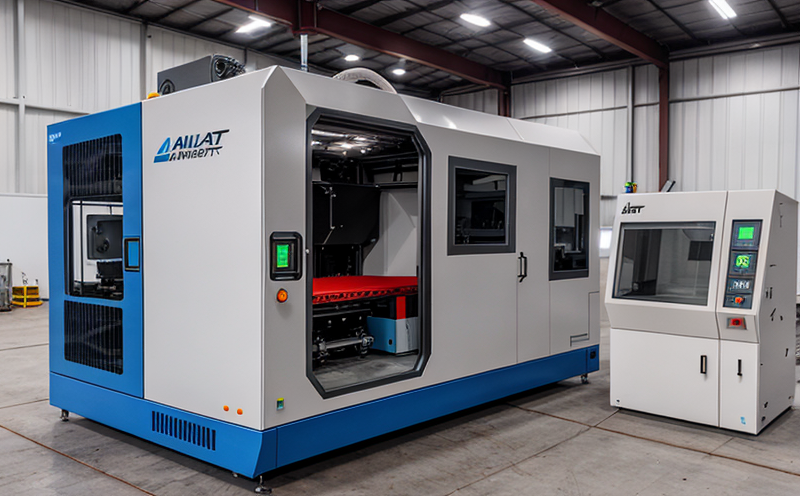ASTM F3383 Residual Stress Testing in AM
The ASTM F3383 standard provides a critical framework for assessing residual stress in parts produced through additive manufacturing (AM) processes. This is essential because the internal stresses generated during the AM process can influence the mechanical properties, dimensional stability, and durability of the final product.
Residual stress arises due to thermal gradients, differences in material expansion during cooling, and the inherent stresses from the welding-like nature of layer-by-layer deposition characteristic of AM. The ASTM F3383 method allows manufacturers to quantify these stresses using a combination of non-destructive testing (NDT) techniques such as X-ray diffraction (XRD), neutron diffraction, and positron annihilation spectroscopy.
The testing process involves several steps: first, the part is prepared by selecting an appropriate specimen that represents the geometry of interest. This can be a coupon cut from the part or a specific section. The specimen must then undergo a heat treatment to ensure it reaches equilibrium thermal conditions before measurement. Once stable, XRD or similar techniques are used to measure stress levels across the cross-section of the material.
Understanding residual stress is vital for ensuring product quality and reliability in industrial manufacturing environments. For instance, aerospace components subjected to extreme environmental conditions must have controlled stress levels to prevent failures during service. In automotive applications, minimizing residual stresses can enhance fatigue resistance and reduce warping or cracking. The ASTM F3383 method ensures that these critical properties are met by providing a standardized approach for measurement.
Another significant benefit of implementing ASTM F3383 is the ability to optimize AM processes. By identifying stress concentrations, manufacturers can adjust parameters such as layer height, build orientation, and cooling rates to reduce unwanted stresses. This not only improves part quality but also leads to more efficient and cost-effective production methods.
Moreover, compliance with ASTM F3383 is crucial for meeting regulatory requirements in various industries. Many sectors, including aerospace and defense, have strict standards governing the integrity of manufactured parts. Adhering to these standards can help companies avoid costly recalls or rework, thereby enhancing their reputation and market position.
The ASTM F3383 method also supports research and development (R&D) efforts in AM technology. By providing accurate data on residual stress levels across different materials and processes, researchers can better understand the behavior of these materials under various conditions. This knowledge can lead to the development of new alloys or process improvements that further enhance part performance.
In summary, ASTM F3383 is a cornerstone in ensuring quality control during AM processes. It provides essential insights into residual stress levels, which are critical for maintaining product integrity and reliability across diverse industries. By leveraging this standard, manufacturers can achieve higher levels of precision and consistency in their production processes, ultimately leading to superior products.
Benefits
The implementation of ASTM F3383 residual stress testing offers numerous advantages for industrial manufacturing operations:
- Enhanced Product Quality: Accurate measurement and control of residual stresses contribute to improved product quality, ensuring parts meet stringent performance requirements.
- Cost Efficiency: By identifying and addressing stress issues early in the production process, companies can reduce scrap rates and rework costs.
- Regulatory Compliance: Adherence to ASTM F3383 helps manufacturers comply with industry-specific regulations, thereby avoiding potential legal and financial penalties.
- Innovation Support: The insights gained from ASTM F3383 testing can fuel innovations in AM processes and materials, driving technological advancements.
- Demand Satisfaction: Meeting customer expectations for high-quality products strengthens market presence and fosters long-term relationships with clients.
- Risk Mitigation: Early detection of potential issues through ASTM F3383 testing minimizes risks associated with product failures in service environments.
In conclusion, the benefits of implementing ASTM F3383 are manifold, encompassing both operational efficiency and strategic growth opportunities for industrial manufacturers.
Environmental and Sustainability Contributions
The application of ASTM F3383 in AM testing contributes significantly to environmental sustainability through several mechanisms:
- Energy Efficiency: By optimizing the parameters for residual stress reduction, manufacturers can reduce energy consumption during production processes. This aligns with broader efforts towards reducing carbon footprints.
- Material Utilization: Minimizing residual stresses through controlled process conditions enhances material utilization efficiency, leading to less waste and lower resource demands.
- Eco-friendly Products: Ensuring product quality through ASTM F3383 helps in creating products that are more durable and reliable, reducing the need for frequent replacements or repairs, which ultimately lowers environmental impact.
- Life Cycle Assessment: Improved product integrity achieved with ASTM F3383 can contribute positively to a company's life cycle assessment by extending product lifespan and reducing lifecycle emissions.
- Supply Chain Sustainability: By adopting this standard, manufacturers set an example for sustainability practices that can influence their entire supply chain, encouraging others to follow suit.
The integration of ASTM F3383 into AM processes not only enhances product quality but also supports broader environmental goals, fostering a more sustainable industrial landscape.
Competitive Advantage and Market Impact
The use of ASTM F3383 residual stress testing in additive manufacturing provides significant competitive advantages for companies operating within the sector:
- Innovation Leadership: By being at the forefront of implementing advanced testing methods, organizations can differentiate themselves through cutting-edge technology.
- Customer Trust and Satisfaction: Demonstrating commitment to quality standards like ASTM F3383 builds trust among customers, leading to increased customer satisfaction and loyalty.
- Premium Market Positioning: Companies that excel in residual stress management can position themselves as premium providers of AM parts, attracting clients seeking superior product offerings.
- Risk Management: Early identification and mitigation of potential issues through ASTM F3383 testing help companies manage risks more effectively, ensuring consistent performance across their operations.
- Strategic Partnerships: Establishing partnerships with organizations that adhere to high-quality standards like ASTM F3383 can open doors for strategic alliances and collaborations.
In the competitive arena of industrial manufacturing, these advantages help companies stand out, enhancing their market position and driving sustainable growth.





